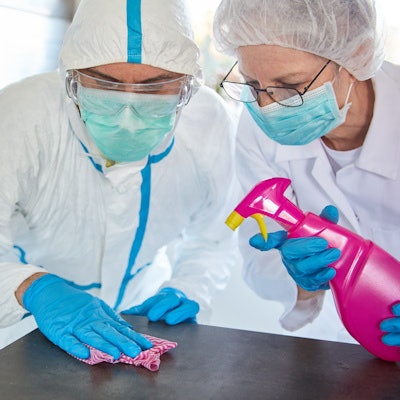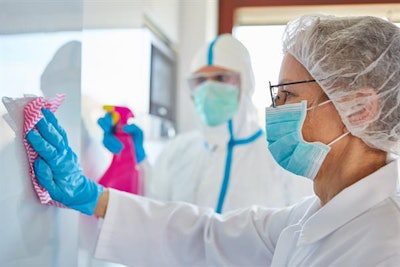
Cleaning procedures for CT units used to scan COVID-19 patients have remained a hot topic since March, but now that it's becoming clear the disease can cause brain alterations, more consideration is being given to how radiology departments are dealing with infection control in the MRI suite.
Since the HIV/AIDS epidemic in the 1980s, there has been "a gradual change from very little concern about body fluids to trying to guess who was a high-risk patient and finally to universal precautions where everyone is assumed to be an infection risk," Dr. Catherine Mandel, MRI radiologist at the Swinburne University of Technology in Melbourne, Australia, told AuntMinnieEurope.com. Similar changes in practice may now occur in terms of respiratory infections, suggesting that in some ways the COVID-19 pandemic could make the world a cleaner, safer place, especially for those at increased risk of, or from, infections, she added.
International standards for MRI hygiene remain in short supply, however, and this area tends to be organized individually by each hospital, and the few publications in this area do not give clear recommendations for radiology departments.
 Imaging facilities have put an even greater emphasis on infection control since the COVID-19 outbreak.
Imaging facilities have put an even greater emphasis on infection control since the COVID-19 outbreak.Among the important questions to consider are the following: How do you handle the issue of airflow? How can you clean inside the bore? Should you have different cleaning protocols for confirmed infected patients and for others? Because it seems almost impossible to exclude SARS-CoV-2 (unless the patient is in complete and total isolation for two weeks), should you assume everyone is a potential infection risk?
To seek answers to these questions, we asked three MRI specialists to explain how they handle infection control in their hospitals.
Felicity Lacchin, MRI superintendent radiographer, University College London Hospital
When we clean the MRI scanner, we do not stop the airflow. The timing depends on the ventilation, and in our MRI area, the process takes about 20 minutes. Different hospitals will have different timings, depending on their ventilation system.
 Felicity Lacchin.
Felicity Lacchin.The radiographers reach into the bore to clean the machine, but we are researching a suitable alternative. As per infection control guidelines, wiping the equipment with disinfectant wipes thoroughly is sufficient and no additional sprays are used.
For suspected/confirmed COVID-19 cases, all equipment that cannot be covered or removed from the environment is cleaned after a patient's examination. For any other patient, we only clean the scanner/coils and any additional areas like cannulation chairs/lockers.
At the height of the pandemic, all patients coming through the emergency department were treated as suspected cases, so the number was quite high. Reviewing the MRI schedule for this week (late June), we had one on Monday, none on Tuesday, two on Wednesday, and none booked for tomorrow.
My general advice is to do the following:
- Designate a scanner for all suspected/positive patients
- Ensure staff are kept informed of personal protective equipment (PPE) and cleaning guidelines
- Establish an inpatient and outpatient pathway for suspected/positive patients
- Establish a pathway to identify patients that may have been a clinical risk if they were not scanned during the height of the pandemic, i.e. two-week wait, cancer follow-ups.
- Establish a pathway for COVID-19 shielded patients (i.e., patients who are clinically extremely vulnerable)
- Review pathways regularly -- there were numerous changes weekly when the pandemic was at its height
- Review protocols with radiologists -- for instance, University College London Hospital now includes arterial spin labelling (ASL) for all patients with suspected or confirmed COVID-19 because evidence suggests there is a vascular component to the disease.
Prof. Dr. Thomas J. Vogl, PhD, head of the Department of Diagnostic and Interventional Radiology, Frankfurt University Hospital, Germany
 Prof. Dr. Thomas J. Vogl, PhD.
Prof. Dr. Thomas J. Vogl, PhD.At Frankfurt, we have conducted more than 100 CT scans but only a handful of MRI exams on suspected/known COVID-19 patients. We do have a strict disinfection protocol for cleaning the MRI unit and the whole room. Everything is emptied and the airflow is stopped. The cleaning of the inner bore of the scanner is done with special liquid disinfection. We try to allow about three hours between patients. Disinfection of the room is done by special cleaners wearing full PPE.
Prof. Dr. Alexander Radbruch, chair of diagnostic and interventional neuroradiology, Rheinische Friedrich Wilhelms University Bonn, Germany
We have standard operating procedures (SOPs) in our hospital that require thorough disinfection of all surfaces of the MRI, including the bore after each patient with suspected COVID-19. After the cleaning is complete, it is mandatory to wait for another hour until the next patient can be assessed again.
 Prof. Dr. Alexander Radbruch.
Prof. Dr. Alexander Radbruch.We do not have any plans to stop the airflow in the MRI. We assume that a consistent airflow might help to change the potentially contaminated air in the scanner.
Our SOPs include a standard wipe disinfection within the bore. We do not believe any additional spray disinfection or any room nebulization are necessary. The SOPs are the same for all contagious patients within the MRI suite.
Overall the number of cases was still extremely low in Bonn by late June. We haven't had to organize any MRI scans of the brain to date, so everything is just a precautionary approach. But I can report the SOPs that are prepared. We have performed six cardiac MRIs and 25 chest CTs.
Generally, we are lucky that the number of patients with COVID-19 is relatively low here. However, in case the number rises, we are well prepared.
Other sources of advice
The Society for Cardiovascular MR is one of many organizations to produce guidelines on procedures to follow when scanning patients with COVID-19. Its preparedness tool kit is available free of charge.
According to a statement issued on 29 April 2020 by the U.K. Society of Radiographers, "Because of metallic components in some masks, deflection in MRI can occur and there is a potential for the masks to become ineffective. This applies to patients and staff. Please be aware and, if required, discuss with your infection control team."
Also, the American College of Radiology has released these recommendations:
- Although the actual instructions and strategies for cleaning and disinfection of MRI machines will vary by location and the availability of PPE, 60 minutes of downtime between patients is suggested, after all surfaces have been thoroughly cleaned.
- Do not bring powered air-purifying ventilators into Zone IV. There are potential adverse interaction risks with the MRI's ferromagnetic components. You can avoid the risk by making sure the PPE doesn't contain any magnetic components. If magnetic components are present, providers should remove them and temporarily replace them with tape.
- For inpatients who have metal strips their masks, fit them with MRI-safe alternatives before bringing them to the radiology department. In situations where doing so isn't possible, be sure to remove the metallic strip from the facemask before bringing them into the imaging suite. When possible, substitute the strips with tape.
Of the pre-COVID-19 material, the October 2017 blog written by MRI technologist Tony Dandino from Cincinnati Children's Hospital is worth a read.



















